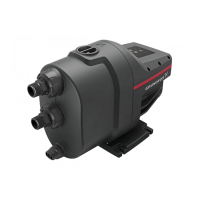6.3 Motor protection
The pump incorporates current- and temperature-
dependent motor protection. If the pump is blocked or
otherwise overloaded, the built-in thermal switch will
cut out. When the motor has cooled sufficiently, it will
restart automatically.
No external motor protection is required.
7. Starting up the product
Do not turn on the power supply until the
pump has been filled with liquid.
7.1 Priming the product
1. Unscrew the priming plug and pour at least 1.7
litres (0.45 gallons) of water into the pump
housing.
2. Screw the priming plug on again.
Example:
TM075342
Priming the pump
If the suction depth exceeds 6 m (20 ft), it
may be necessary to prime the pump more
than once.
Always tighten priming and drain plugs by
hand.
7.2 Starting up the pump
After installing and priming, follow the following steps
to start up the pump.
1. Prime the pump according to the priming
instructions.
2. Open all isolating valves.
3. Open the tapping point that is the highest or
furthest away from the pump to let out air trapped
in the system.
4. Turn on the pump's power supply. All the
symbols on the operating panel will light up
briefly. The Stop icon remains on.
5. Press the Start/Stop button to start the pump. If
there is a suction lift, it may take up to five
minutes before the pump delivers water
depending on the length and diameter of the inlet
pipe.
6. When the water flows through the tapping point
without air, close the tapping point. The pump will
stop after approx. 10 seconds.
7. The startup is now completed, and the pump is
ready for operation.
7.3 Operation
7.3.1 Normal operation
When water is consumed in the water supply system,
the pump starts if the starting conditions of the pump
are fulfilled. This happens, for example, when a tap is
opened, making the pressure in the system drop.
The pump stops when the consumption stops, i.e.
when the tap is closed.
7.3.1.1 Starting and stopping conditions
Starting conditions
The pump starts when at least one of the following
conditions is fulfilled:
• The flow is higher than Qmin (1.5 l/min).
• The pressure is lower than pstart.
Stopping conditions
The pump stops with a time delay of 10 seconds
when both of the following conditions are fulfilled:
• The flow is lower than Qmin (1.5 l/min).
• The pressure is higher than pstart.
The pstart values are shown in Technical data.
7.4
Shaft seal run-in
The shaft seal faces are lubricated by the pumped
liquid. A slight leakage from the shaft seal of up to 10
ml per day or 8 to 10 drops per hour may occur.
Under normal conditions, the leaking liquid will
evaporate. As a result, no leakage will be detected.
When the pump is started for the first time, or when
the shaft seal has been replaced, a certain run-in
period is required before the leakage is reduced to an
acceptable level. The time required for this depends
on the operating conditions, that is, every time the
operating conditions change, a new run-in period will
be started.
14
English (GB)

